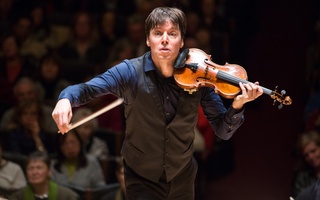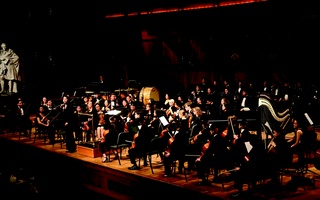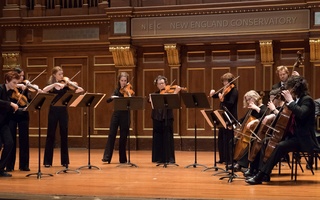A haunting presence hung over Jordan Hall during the Boston Modern Orchestra Project’s first concert of the 2016-2017 season at the New England Conservatory. Throughout the final piece of the night, Steven Stucky’s inventive “Chamber Concerto”, the air felt solemn and gloomy in spite of an adrenaline-fueled conclusion. The recent memory of Stucky’s death in February was on the minds of many, lending an emotional charge to the already powerful work wonderfully performed by the small orchestra. Under the direction of conductor Gil Rose, the concert, billed as “A special tribute to Steven Stucky,” indeed provided a fitting commemoration to the contemporary American giant while also doing justice to the works of the other composers featured on the program.
After some witty and conversational remarks, Rose started off the program with Michael Colgrass’s eclectic “The Schubert Birds”, which careened between piercing screeches, dreamlike swells, and bursts of jazz. Building upon Franz Schubert’s Kupelwieser Waltz, the piece explored the variations in the 19TH-century composer’s work and provided a great opportunity for the orchestra to show off a full range of orchestral colors: From the start, the violins trilled eerily on harmonics, ingeniously imitating the sound of chirping birds. What followed was a trancelike section shaded excellently by vibraphone and crotales in the percussion. The woodwinds and timpani introduced some violent shrieks in later sections, and with such powerful interjections, the piece never lost control over the audience’s attention.
The next work, the 1952 Pulitzer-winning Symphony Concertante by Harvard alumnus Gail T. Kubik ’38, provided an invigorating and bravura display of the abilities of the three soloists: trumpeter Terry Everson, violist Jing Peng, and pianist Vivian Choi. From the angular opening melody performed in unison with the orchestra to the buoyant spirit and wonder that pervaded the last movement, the soloists, particularly the superbly expressive Peng and the colorful Everson, shone through. Despite the Coplandesque directness and sincerity of the outer movements, what ended up striking the deepest was the beautiful second movement, which featured an enchanting duet between these two performers.
Another highlight of the night was the rousing Partita in C for piano and orchestra, composed by yet another Harvard alumnus, Harold S. Shapero ’41. While Choi didn’t look completely comfortable during the Kubik, she seemed in command in this piece, with a steely virtuosity and a regality that perfectly fit the opening French overture feel. Interesting musical ideas that played with Baroque structure gave the piece some levity, with a sleazy burlesque and an arresting aria colored by vibraphone.
The concert finally culminated with Stucky’s Concerto, a dazzling display of orchestral color that built up a palpable sense of tension over its 20-minute length, starting from a simple motif between dreamy winds and ending with soaring string melodies, lively runs between soloists, and a final frenetic burst of energy. Each section of the orchestra, most making do with just two performers per instrument, brought its own flavor to the aural palette of the orchestra, from the thundering timpani to the eerie harp.
Tackling modern music, with all of its rhythmic, harmonic, and logistical complexities, can often be a daunting endeavor, but the Boston Modern Orchestra Project was more than up for the challenge. Especially for such a small group, producing such moving and immersive landscapes and doing justice to so many obscure works was an amazing feat.
Read more in Arts
Music Video Breakdown: ‘Shout Out to My Ex’ by Little MixRecommended Articles
-
HRO Gives Soaring Performance of Mahler and SibeliusLed by conductor and music director Federico Cortese, the undergraduate orchestra delivered an enthralling performance for Junior Parents’ Weekend in Sanders Theatre.
-
 Joshua Bell and Academy of St Martin in the Fields Stun Symphony Hall
Joshua Bell and Academy of St Martin in the Fields Stun Symphony Hall -
 HRO Winter Concerto Short but Sweet
HRO Winter Concerto Short but Sweet -
 Handel and Haydn Society Breathes Life into Bach
Handel and Haydn Society Breathes Life into Bach -
Joan Tower Celebrates an 80-Year Journey with Concert at Jordan HallThe Boston Modern Orchestra Project (BMOP), and featuring soloists Carol Wincenc and Adrian Morejon and conducted by Gil Rose, performed Tower’s music stunningly and with an evocative sense of the landscapes the music represented.













